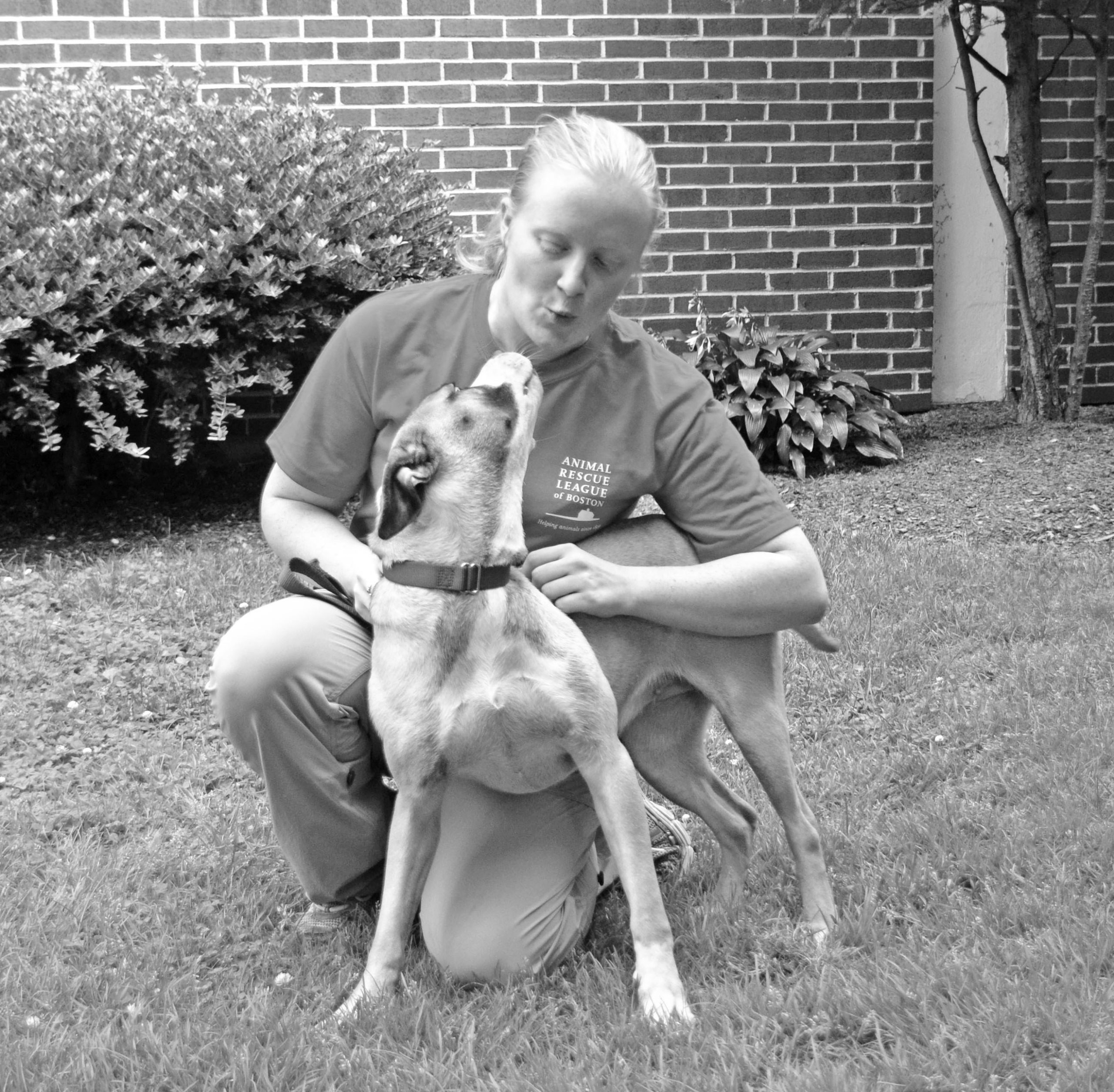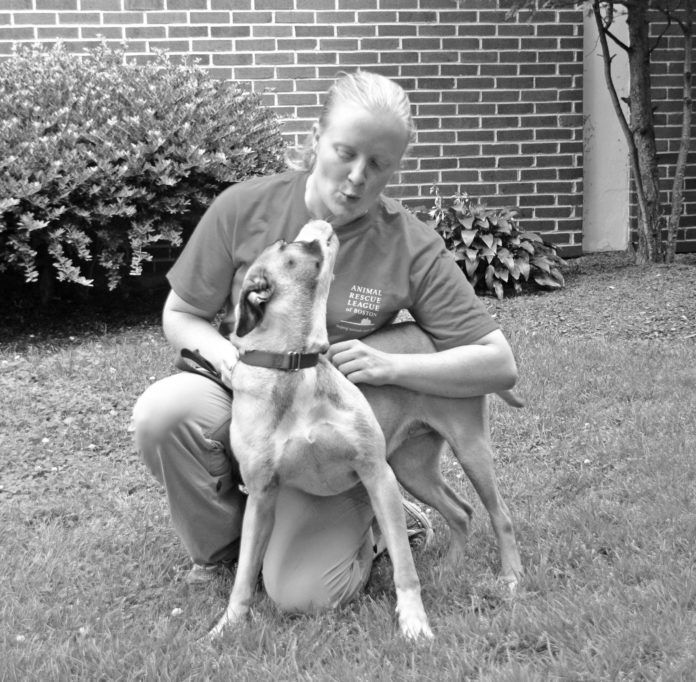“A lot of people used to think of the animal shelter as a sad place,” says Tufts veterinarian Emily McCobb, DVM. “They wouldn’t want to go. The animals needed a home, and it felt bad just to see them.

“But now, says Dr. McCobb, “shelters are coming to be thought of as community resources. They can help you.”
How? To find out, we sat down with Dr. McCobb, Director of the Shelter Medicine Program at the Cummings School, at her office on the Tufts veterinary campus.
Your Dog: If you’re not looking for a dog to adopt, how can a shelter help you?
Dr. McCobb: More and more shelters can assist someone who already has a pet dog with a behavior problem, whether or not the dog came from the shelter. The shelter has a behavior specialist on staff — perhaps a veterinarian who specializes in animal behavior, or a certified applied animal behaviorist or a certified professional dog trainer. That person is there in the first place to make sure the dogs housed at the shelter have environmental enrichment in the form of getting enough walks and having toys to keep them mentally sound. They also assess the dogs to make sure they have sound temperaments and can make good pets. But in addition, the behaviorists often serve as a resource for the community. They may teach classes on behavior, for instance. Or they can answer questions. In some cases, they have a consultation service. For a fee, which goes into the shelter’s coffers to take care of the homeless dogs there, they can advise owners on how to handle a behavior problem with their dog.
Your Dog: Why would a shelter be willing to engage with the community like that, when their mission is to take care of stray dogs and, when possible, find them homes?
Dr. McCobb: The primary reason people relinquish their dogs to shelters is behavioral problems, not medical ones. So if someone on staff can help insure that a dog who already lives with somebody will remain a ‘forever’ dog in that person’s home, he or she is keeping that dog out of the shelter and saving a spot for a homeless dog who has nowhere else to go.
Your Dog: Are there any ways for people to become involved in shelter work?
Dr. McCobb: There are a number of ways for people to become involved — and meet like-minded people while they’re at it. In an ideal world, dogs aren’t kenneled all day long, so one of the things shelters are working on is getting dogs outside — for walks, for play time. Shelters are also working on training their dogs in basic manners to assist them in their new homes. A dog who can sit and greet potential adopters calmly because he has had some outside time is going to become part of someone’s family more quickly. So imagine, if you have 50 dogs in a shelter and you want to get each dog out on two or three walks a day — that takes a lot of volunteers.
Your Dog: Anything else people can do besides walk dogs?
Dr. McCobb: A lot of shelters hold fundraisers, too. Maybe a shelter needs your ability to get the word out about a fundraiser on Facebook or Twitter or even to put up signs or tell your friends. You can also donate needed items.
Your Dog: What are your thoughts for people who have a negative view of shelters because they are involved in euthanizing unwanted dogs?
Dr. McCobb: First, many fewer dogs than ever are being euthanized. In the 1970s, shelters put down 13 to 15 million cats and dogs every year. Today, thanks to better spay/neuter programs and more vigorous efforts to promote adoption, that number has fallen to an estimated 3.8 million annually and continues to trend downward. But numbers aside, I would caution people not to be judgmental. People talk about ‘high-kill’ shelters versus ‘low-kill’ facilities. I would prefer they not use those terms. It makes it sound as though shelters themselves are responsible for the problem. I can assure you that if there is a shelter in someone’s community that has to perform a lot of euthanasia, no one at the shelter is happy about that. It means there’s a problem at the community level, not at the shelter per se. Concerned people need to take a step back and look at what’s happening community-wide to see what’s causing all the euthanasia. Are too many people breeding dogs that can’t be raised to live with human families, perhaps unusually aggressive dogs? Is there an economic crisis that is causing people to surrender their dogs? Does the community not have adequate low-cost spay/neuter resources?
Whatever the reason, there has to be some agency in every community that deals with all the stray dogs. Putting the blame on the shelter for euthanizing those dogs that no one wants or that aren’t socializable isn’t pointing a finger at the source of the problem and isn’t going to solve it, either.
Your Dog: What can people do to mitigate the problem short of some community organizing effort?
Dr. McCobb: One of the number one things people can do is license their dogs. In most cases, the money we have to pay for Animal Control comes from those fees. That helps return lost dogs to their families and keeps dogs off the streets in general. In Boston, less than 50 percent of owners license their dogs. In Worcester, New England’s second largest city, the figure might be as low as 30 percent.
Your Dog: Are there any other ways people can keep dogs out of shelters other than by paying the licensing fees to their municipality if they own a dog?
Dr. McCobb: Yes, they can consider adopting their next dog from a shelter. Shelter staff can help match a family to a pet, talking about a household’s activity levels, whether they have a fenced yard, whether there are small children at home, and so on. In addition shelters have a lot of adult dogs, who might serve many families better than a puppy. Many people think they want a puppy. But a lot of older dogs are more mellow, easier, already trained. They can be left home alone for longer periods. Also, their personalities are already formed, so you know what you’re getting. Dogs reach behavioral maturity at the age of three. Any dog younger than three is something of an unknown.
That said, if someone goes to a shelter and the facility doesn’t have the kind of dog they’re looking for, they should not feel bad about adopting a dog from some other place or about getting one from a responsible breeder. Much more important is that the people become the dog’s ‘forever’ family. It’s all about making that good match.





